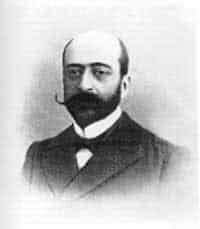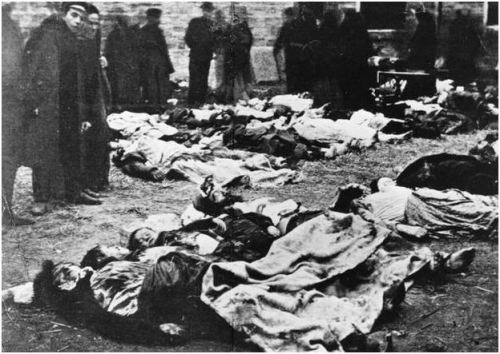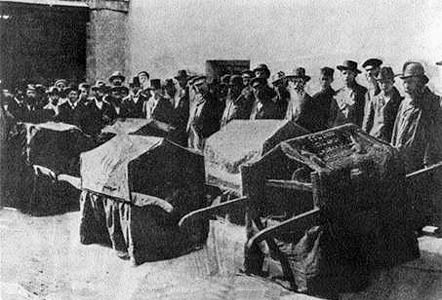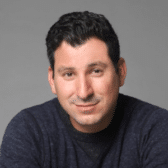There are certain moments in history that seem to change…well…everything. There’s everything before that moment…and everything after it.
And the interesting thing is…the key moments, those ones that change EVERYTHING, they’re not the big, headline moments of history. They’re not the ones with all the pomp and fanfare. They’re the subtle moments that have an outsized impact, the flutter of the butterfly’s wings that lead to a tsunami down the road.
In the case of modern Jewish history, there’s one moment in particular that I think has had a CRAZY impact on the Jewish world as we know it.
And the even crazier thing is…most people have never heard of it.
So what moment is that?

Kishinev, or Chisinau, is the capital and cultural heart of Moldova. In the 19th century, it was part of the Russian Empire, and home to many Jews.

Journalist Pavel Krushevan came to Kishinev in 1897. Krushevan had two distinguishing characteristics: that amazing mustache, and his not-so-amazing hatred of Jews. He turned Kishinev’s only daily newspaper into his personal soapbox, with headlines like “Death to the Jews!” His paper was so popular that the Russian authorities financed a second one based in the capital, taking his anti-Jewish crusade to the big time.
Do you know what happens when you spend years inciting people to hate their neighbors? Well, you’re about to find out.
In early 1903, Kishinev was rocked by the back-to-back deaths of two young Christians. The Jewish community had nothing to do with the deaths, but that didn’t stop Krushevan from using his platform to blame them. He even arranged a date for the local Christians to “execute bloody justice.” Yep, that’s an exact quote. He chose Easter Sunday, which in 1903 was also the last day of Passover.
Krushevan was serious about making sure this massacre happened. He kept tensions high by hanging out propaganda pamphlets about a Jewish plot to take over the world. Folks from all over poured into Kishinev, eager to take revenge.
Kishinev’s Jews were like, um, hello, is someone going to step in here? But the Chief of Police responded that a pogrom would serve them right. And when the riot started, everyone, from the working class to the clergy to the aristocrats, showed up to terrorize their Jewish neighbors.

The Jews tried to fight back. Hundreds of men armed with makeshift weapons stood watch. And I’ve read about brave families who fought off attackers with canes and gardening tools. But the police broke up the self-defense squads. Not that they would have made much of a difference. Because thousands participated in the pogrom. They murdered 49 Jews. Wounded 500. Destroyed thousands of homes and businesses. Raped countless women.
Okay, are you still with me? Good. Now, if I stopped there, you’d say, got it, there was anti-Jewish sentiment in Europe. Heard that story before. You might even ask, why focus on this story? Other pogroms across Eastern Europe killed over 40,000 Jews! Why is Kishinev the pogrom that changed everything?
Here’s where the story gets really juicy.
Lean in, you gotta hear this.
In Odessa, the Jewish head of the Kishinev Historical Commission was collecting evidence, in the off-chance the murderers were brought to trial. He sent 30-year-old Chaim Nachman Bialik – who would one day be crowned the Jewish national poet – to gather testimony from Kishinev’s Jews. And boy, did Bialik deliver, returning to Odessa with four notebooks of evidence. He distilled these testimonies into a wrenching poem called B’Ir HaHariga. In the City of Slaughter.
Ever been to a Jewish prayer service on Yom Kippur or Tisha B’av? You might be familiar with the kinnot, or lamentations, that mourn Jewish deaths over the ages. The liturgy makes those martyrs sound… heroic. But though Bialik’s poem had the cadence of a prayer, he made Kishinev’s Jews look… pathetic. Pitiable. “Repugnant,” in the words of Micah Goodman. With acid irony, Bialik compared Kishinev’s cowering victims to legendary Jewish warriors like the Maccabees.

Remember when I said there was Jewish resistance? Why didn’t Bialik mention that? Well, Bialik was a passionate Zionist. He wanted to call diaspora Jews back to their ancestral homeland. And he thought the only way to do that was to shock them. To purposefully emphasize the worst of the diaspora.
Here’s what’s crazy: It worked. Bialik’s poem changed everything. Jewish youth formed self-defense squads – one of which became the precursor to the Israeli Army. Thousands mobilized, eager to prove that they would not forget their Maccabean heritage. Anita Shapira, one of my favorite historians, said,
“The impotent rage was a kind of revolutionary explosive charge that demolished traditional Jewish responses, insisting on a new demonstration that the Jew was also a human being, whose blood would not be shed with impunity.”
For that reason, a young Jew named Pinhas Dashevski even tried to assassinate Krushevan. Kishinev had battered and bloodied Europe’s Jews. Bialik’s poem reminded them of their lineage of warriors and kings. And by trying to assassinate Krushevan, Dashevski was reclaiming that legacy.
Meanwhile, in America, Jewish groups pressured President Theodore Roosevelt to appeal to the Russian government on behalf of Russia’s Jews. (Which the Russians ignored.) In Basel, Switzerland, Theodore Herzl – the father of modern political Zionism – opened the Sixth Zionist Congress with the words “Kishinev exists wherever Jews undergo bodily or spiritual torture.” Bialik’s viral poem had turned Kishinev into shorthand for all Jewish suffering. Herzl was so convinced that Europe would never be safe for Jews that he even suggested the Jews go to East Africa for a while as they waited to get to their ancestral homeland. Crazy, right? Check out our video on the Uganda Plan for more details.
But the East Africa plan never materialized. So European Jewry turned their eyes to more welcoming shores. Between 1900 and 1914, 1.5 million Eastern European Jews emigrated to the United States. American Jews lobbied to keep American borders open to Jewish refugees, even as nativists urged immigration restrictions.
But you want to hear something really wild?
The Kishinev pogrom mobilized the Black community, too. Black and Jewish activists publicly and explicitly compared anti-Black and anti-Jewish violence. Because their circumstances may have been different, but the pain of both communities was really similar. Six years after Kishinev, a multi-racial coalition, including a Russian Jewish immigrant, founded the NAACP.
And in Russia, someone else had learned a lesson from the pogrom.
But his lesson was… not a good one.
Remember this guy? Pavel Krushevan, the guy who incited the pogrom? He learned that fake news works. Shortly after Kishinev, he published a 24-chapter conspiracy theory called The Protocols of the Elders of Zion.
Quick note on conspiracy theories. Yes, some could theoretically be true. Of course.
BUT –
Conspiracy theorists ARE REALLY DANGEROUS BECAUSE they have access to all the evidence they need to understand the truth, but they choose to ignore that and peddle their ideas. They believe in their theory despite unequivocal evidence.
And, the granddaddy of anti-Semitic conspiracy theories that claims that Jews destroy governments, control the media and the banks, enslave non-Jews, etc. etc. It’s all part of our dastardly plan to rule the world with an iron fist. Mwahahaha. Cmon, stop it.
The Protocols have enjoyed a long and nasty legacy all over the world. They wormed their way into German curriculum during the Nazi era. They formed the backbone of anti-Jewish Soviet propaganda during the Cold War. They inspired a 41-part drama series that aired on Egyptian state TV in 2002. And if you lean in and listen closely, you’ll hear echoes of the Protocols in America, too. “Rothschild,” “globalists,” “Jewish space lasers”… all evidence of the Protocols’ subtle and lingering influence.
Thanks, Krushevan.
So… let’s recap. Did Kishinev really change the course of history? I sure think so. It galvanized Jews across the world to form self-defense groups, including the core of the future Israeli army.
It made Herzl desperate enough to suggest the controversial Uganda Plan.
It reshaped global demographics, as over a third of Eastern Europe’s Jews made their way to America or Palestine by 1920.
It reminded Jewish people across the world that they needed their own state.
It even spurred the creation of the NAACP.
I think that if you want to understand Zionism, you gotta understand the Jewish response to Kishinev. Zionism was not just about creating a new Jewish state, but a new Jew with nothing to fear. Want to understand Israelis? You have to know the story of Kishinev.
But do you want to hear something so insane I can’t stop thinking about it? In a turn that would have been unbelievable in 1903, Kishinev is now an unlikely refuge for Europe’s Jews. When Russia invaded Ukraine in 2022, creating an ocean of refugees, Israeli rescue teams stepped up to take in Jews and non-Jews alike. The rescue center was in Kishinev. No longer the City of Slaughter, but a city of sanctuary, made possible by the existence of a Jewish state. I like to think that Chaim Nachman Bialik would have been proud.
